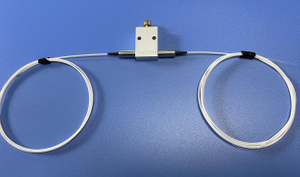- Home1550nm PM Mechanical Adjustable Optical AttenuatorHome » Products » Lasers & Amplifiers » Optical Modules » mVOA » 1550nm PM Mechanical Adjustable Optical Attenuator
Product Number
P/N: PMVOA-102-1550-PM1550-1-L-FA
Product Number
P/N: PMVOA-102-1550-PM1550-1-L-FA
No.
Description
Unit
Parameters
Note
1
Type
-
Polarization Maintaining
2
Operating Wavelength
nm
1530~1570
1550±20
3
Insertion Loss
dB
≤0.8
@25℃
4
Attenuation Range
dB
0.8~60
5
Polarization Extinction Ratio
dB
≥18 (Typ.≥20)
6
Return Loss
dB
≥50
7
Maximum Optical Power
mW
≤500
8
Working axis
-
Slow Axis Input, Both Axis Working
9
Dimensions
mm
26×18×8
L×W×H
10
Fiber Type
-
PM1550 fiber,with 900μm loose tube
Panda Fiber
11
Maximum Tensile Load
N
≤5
12
Connector Type
-
FC/APC
13
Pigtail Length
m
≥1.0
14
Operating Temperature
℃
-5~+70
15
Storage Temperature
℃
-40~+85
Note: [1] The above insertion loss data is the loss at room temperature without connectors. If the product has connectors, the insertion loss is based on the loss of the original device plus the connector loss of 0.15dB/head, and the extinction ratio is reduced by 2dB on the basis of the original extinction ratio index. The key of the connector is aligned with the slow axis.
No.
Description
Unit
Parameters
Note
1
Type
-
Polarization Maintaining
2
Operating Wavelength
nm
1530~1570
1550±20
3
Insertion Loss
dB
≤0.8
@25℃
4
Attenuation Range
dB
0.8~60
5
Polarization Extinction Ratio
dB
≥18 (Typ.≥20)
6
Return Loss
dB
≥50
7
Maximum Optical Power
mW
≤500
8
Working axis
-
Slow Axis Input, Both Axis Working
9
Dimensions
mm
26×18×8
L×W×H
10
Fiber Type
-
PM1550 fiber,with 900μm loose tube
Panda Fiber
11
Maximum Tensile Load
N
≤5
12
Connector Type
-
FC/APC
13
Pigtail Length
m
≥1.0
14
Operating Temperature
℃
-5~+70
15
Storage Temperature
℃
-40~+85
Note: [1] The above insertion loss data is the loss at room temperature without connectors. If the product has connectors, the insertion loss is based on the loss of the original device plus the connector loss of 0.15dB/head, and the extinction ratio is reduced by 2dB on the basis of the original extinction ratio index. The key of the connector is aligned with the slow axis.
Related Products
OUR FOCUSCONTACT USThe core team of the company is composed of experienced academics and industry elites.FEATURED PRODUCTS
PRODUCT CATEGORY
NEWS & EVENTS
SUPPORT & DOWNLOAD










